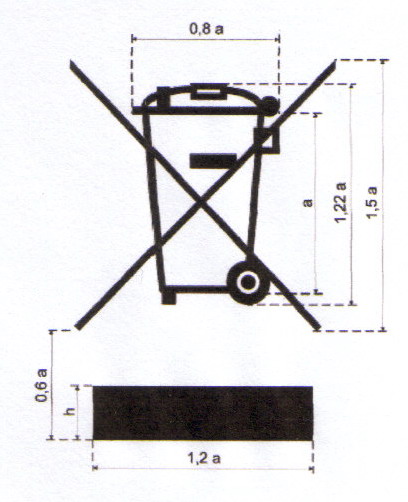

Home | Testing Services | Technical Information | Consulting | Customer Services | Careers | Contact Us
![]()
►TOYS
►REGULATIONS OF DIFFERENT COUNTRIES

WEEE Directive – 2002/96/EC (and its amendments) – EU Directive on waste electrical and electronic equipment (WEEE)
The EEE shall include a unique
identification of the producer, which can be the brand name, trademark, company registration
number or other suitable means of identification.
The
above registration shall be registered with each
The Symbol “Crossed-Out
Wheeled Bin”
The
EEE shall include the marking of
a crossed-out wheeled bin with a bar underneath, as shown below. This marking shall be accessible, durable,
legible and indelible. It shall remain legible and not easily removed or
show curling after rubbing for 15 s with a cloth soaked in water, then rubbing
for another 15 s with a cloth soaked in petroleum spirit (e.g. hexane).
Markings merely printed on plain paper labels, without a protective coating,
are likely to be obliterated by such rubbing and fail.
The
height (h): h>0.3a and h>1mm; the dimensional relationship
of the marking is as follows:

WEEE Directive
The importer / manufacturer can choose to fulfil the following obligation
either individually* or by joining a collective scheme**.
Under the WEEE Directive, importers and manufacturers shall provide at least for the financing of the
collection, treatment, recovery and environmentally sound disposal of electronic
wastes from private households deposited at collection facilities.
Importers
and manufacturers shall meet the targets for recovery of electronic
wastes as specified in the WEEE Directive.
*Individual take back plan
Importers and manufacturers have to consult national legislation in order
to write their own waste management plan. The plan is needed to be submitted to
the UK supervising governmental agencies for approval.
It is advised that consultation should be via national authorities
(European or national trade/industry association).
**Collective take back system
Importers and manufacturers can become a member of a national collective
take back system in the UK / EU Member States.
The Directive applies
to the following electrical and electronic equipment (EEE)***
1. Large household appliances
2. Small household appliances
3. IT and telecommunications equipment
4. Consumer equipment
5. Lighting equipment
6. Electrical and electronic tools (with the exception of large-scale
stationary industrial tools)
7. Toys, leisure and sports equipment
8. Automatic dispensers
9. Electric light bulbs
10.Luminaires in households
***EEE in this Directive
are defined as those designed for use with a voltage rating not
exceeding 1000 volts for alternating current and 1500 volts for direct current
Product design
This Directive encourages the design and production of electrical and
electronic equipment which take into account and facilitate dismantling and
recovery, in particular the reuse and recycling of WEEE, their components and
materials.
Separate collection
Systems are set up allowing final holders and distributors to return such
waste at least free of charge. EU Member States shall ensure the availability
and accessibility of the necessary collection facilities
Distributors shall be responsible for ensuring that such waste can be
returned to the distributor at least free of charge
Producers are allowed to set up and operate individual and/or collective
take-back systems for WEEE from private households
EU Member States shall ensure that all WEEE collected is transported to
treatment*** facilities unless the appliances are reused as a whole.
EU Member States shall ensure that by 31 December 2006 at the latest
a rate of separate collection of at least four kilograms on average per
inhabitant per year of WEEE from private households is achieved.
EU Member States shall establish a new mandatory target of seprate
collection rate by 31 December 2008.
***treatment means any activity after the WEEE has been handed over to a
facility for depollution, disassembly, shredding, recovery or preparation for
disposal and any other operation carried out for the recovery and/or the
disposal of the WEEE;
Treatment***
Producers or third parties should set up systems to provide for the
treatment of WEEE
The treatment shall, as a minimum, include the removal of all fluids
A selective treatment is included in Annex B
EU Member States may set up minimum quality standards for the treatment of
collected WEEE.
EU Member States shall ensure that any establishment or undertaking
carrying out treatment operations obtains a permit from the competent
authorities
EU Member States shall ensure that any establishment or undertaking
carrying out treatment operations stores and treats WEEE in compliance with the
technical requirements set out in Annex C.
***Treatment means any activity after the WEEE has been handed over to a
facility for depollution, disassembly, shredding, recovery or preparation for
disposal and any other operation carried out for the recovery and/or the
disposal of the WEEE;
Recovery
By 31 December 2006, producers shall meet the following targets:
For WEEE falling under
categories 1 and 10 of Section 3.2.1,
- the rate of recovery shall be increased to a
minimum of 80 % by an average weight per appliance, and
- component, material and substance reuse and
recycling shall be increased to a minimum of 75 % by an average weight per
appliance;
For WEEE falling under
categories 3 and 4 of Section 3.2.1,
- the rate of recovery shall be increased to a
minimum of 75 % by an average weight per appliance, and
- component, material and substance reuse and
recycling shall be increased to a minimum of 65 % by an average weight per
appliance;
For WEEE falling under
categories 2, 5, 6, 7 and 9 of Section 3.2.1,
- the rate of recovery shall be increased to a
minimum of 70 % by an average weight per appliance, and
- component, material and substance reuse and
recycling shall be increased to a minimum of 50 % by an average weight per
appliance;
For gas discharge lamps, the rate of component,
material and substance reuse and recycling shall reach a minimum of 80 % by
weight of the lamps.
Producers or third parties shall keep records on the mass of WEEE, their
components, materials or substances when entering (input) and leaving (output)
the treatment facility and/or when entering (input) the recovery or recycling
facility.
By 31 December 2008, EU Member States shall establish new targets for
recovery and reuse/recycling for the products falling under category 8 of Section
3.2.1
Interpretation
This Directive covers EEE where the basic (primary)
function cannot be fulfilled when the electric current is off. If the
electrical energy is used only for support or control functions this type of
equipment is not covered by the Directive. Examples for the latter are
combustion engine with ignition, gas cooker with electric clock, … etc.
Batteries
Batteries incorporated in EEE once the equipment
becomes waste
This Directive applies to batteries incorporated in
EEE once the equipment becomes waste. In this case, they will be collected
together with the EEE on the basis of this Directive. This has consequences for
producer reponsibility. For batteries incorporated in EEE, battery producer
will only become responsible for further treatment after those batteries are
removed from the collected WEEE. Therefore, the batteries which are collected
together with the WEEE are included in the WEEE collection target and, after
removal, for the collection rate of the battery Directive
Batteries which are incoporated into other products
Batteries which are incoporated into other products
(such as cars or EEE) will be collected automatically together with those other
products at the moment they become waste. On the basis of Directive 2000/53/EC
on End-of-Life Vehicles (ELV) and the WEEE Directive, it is the producer of the
car/EEE who covers the costs of collection, and the collected car/EEE have to
be handed over to an authorised treatment facility. On the basis of the minimum
treatment requirements in those Directives, the batteries are to be removed
from the collected ELV appliance as a minimum treatment requiremnt. From then
on, the battery producer is responsible for covering the costs of further
treatment of the batteries. The interface would be between the battery producer
and the treatment facility when the batteries are removed from the car/EEE.
Exemption
Equipment which is connected with the protection of the essential interests
of the security of EU Member States, arms, munitions and war material shall be
excluded from this Directive. This does not, however, apply to products which
are not intended for specifically military purposes.
Interpretation
For the purpose
of this Directive, the followings are exempted:
-
Fixed
installations like heating plants, industrial installations
-
Lifts
-
Control
and monitoring equipment used in oil and gas electronics
-
Frequency
conveters
- Car radio and other equipment designed for being used in a product covered by the End-of-Life Vehicles (ELV)
© 2005, 2010 Professional Testing & Consulting Ltd. All rights reserved.
